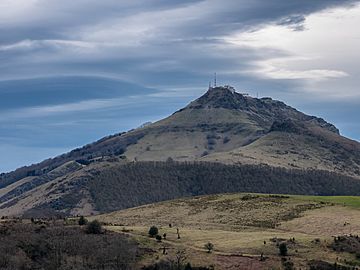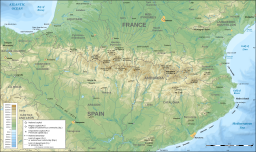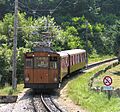Larrun facts for kids
Quick facts for kids Larrun |
|
|---|---|
| La Rhune | |
 |
|
| Highest point | |
| Elevation | 905 m (2,969 ft) |
| Prominence | 670 m (2,200 ft) |
| Geography | |
| Parent range | Pyrenees |
Larrun (also known as La Rhune in modern French) is a mountain in the western Pyrenees mountain range. It stands tall at 905 meters (about 2,969 feet). This mountain is special because it sits right on the border between France and Spain. It's where two traditional Basque areas, Labourd and Navarra, meet.
Contents
History of Larrun
Larrun has always been an important place for the Basque culture. The mountain is covered with ancient stone structures. These include dolmens (old stone tombs) and stone circles. These monuments were built by people in the Neolithic Age, thousands of years ago.
Ancient Beliefs and Myths
Long ago, people believed Larrun was a sacred place. It was part of Basque mythology. Some stories say it was the home of Lehensugea, the very first serpent. Later, the mountain top gained a reputation as an akelarre. This was a place where people believed witches held special meetings. To keep witches away and ensure good weather, local villages paid a monk to live as a hermit (someone who lives alone) on the summit until the 1700s.
Battles and Smuggling Routes
During the Peninsular War in the early 1800s, French soldiers used Larrun as a strong defensive spot. However, on November 10, 1813, forces led by Wellington pushed the French army off the mountain. This happened during the Battle of Nivelle. This victory opened the way for Wellington to march into France.
For many centuries, Larrun and the surrounding area were famous for smuggling. People secretly moved goods across the border here. This route was also used by refugees during the Spanish Civil War and World War II. Smuggling was so important that a local tale says the mountain was once covered in gold. But when bad people tried to take the gold, they burned the trees. The gold then melted and flowed away.
The Start of Tourism
Larrun began to become a popular place for visitors in the mid-1800s. This happened after Eugenie de Montijo, who was the Empress of France, started taking holidays in nearby Biarritz in 1864. She often visited the mountain's summit, making it a fashionable destination.
Larrun Today
Today, Larrun is a very popular spot for walks and hikes. It is the first peak you reach if you start the long Haute Randonnée Pyrénéenne (HRP) walking route from the coast. This route goes all the way across the Pyrenees.
The Little Train
A special train called the Petit train de la Rhune takes visitors to the top of the mountain. This is a rack railway, which means it uses a toothed rail to climb steep slopes. You can catch this train from the French side of the mountain.
Animals and Culture
As you explore the slopes of Larrun, you might see different animals. Cows, a few pottok ponies (a special type of horse), and manech sheep often wander freely. The mountain's unique shape is often seen on souvenirs and logos. Many local inns and restaurants are also named after Larrun.
Images for kids
See also
 In Spanish: Larrún para niños
In Spanish: Larrún para niños



